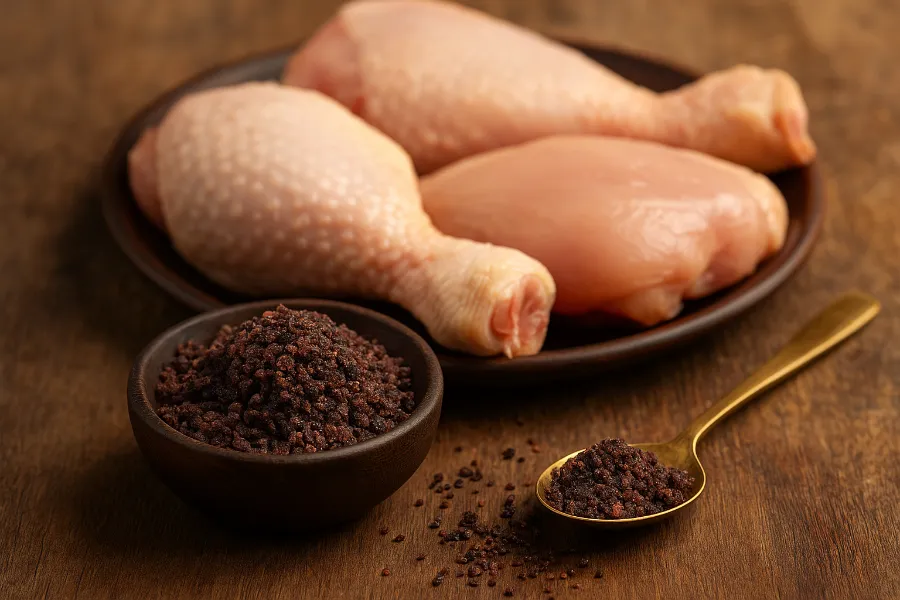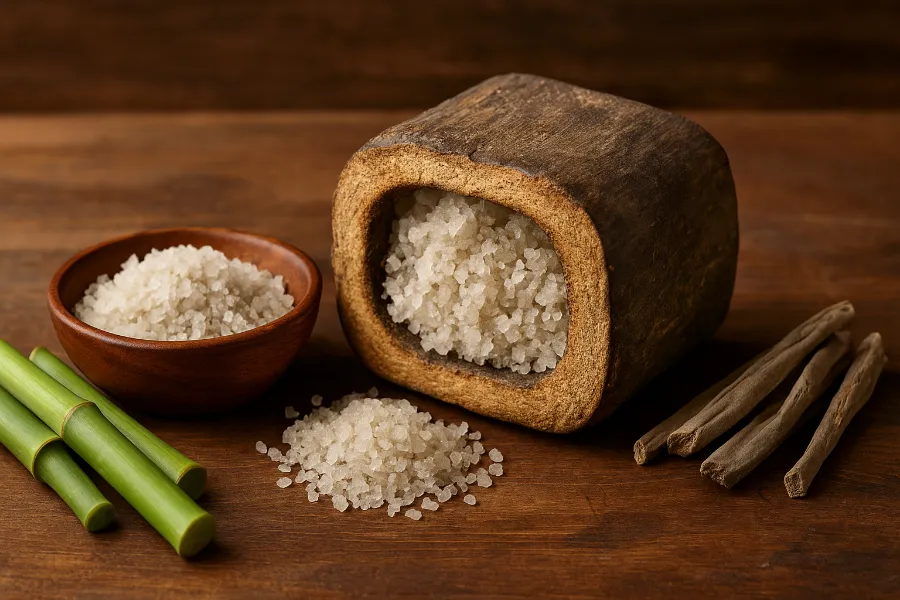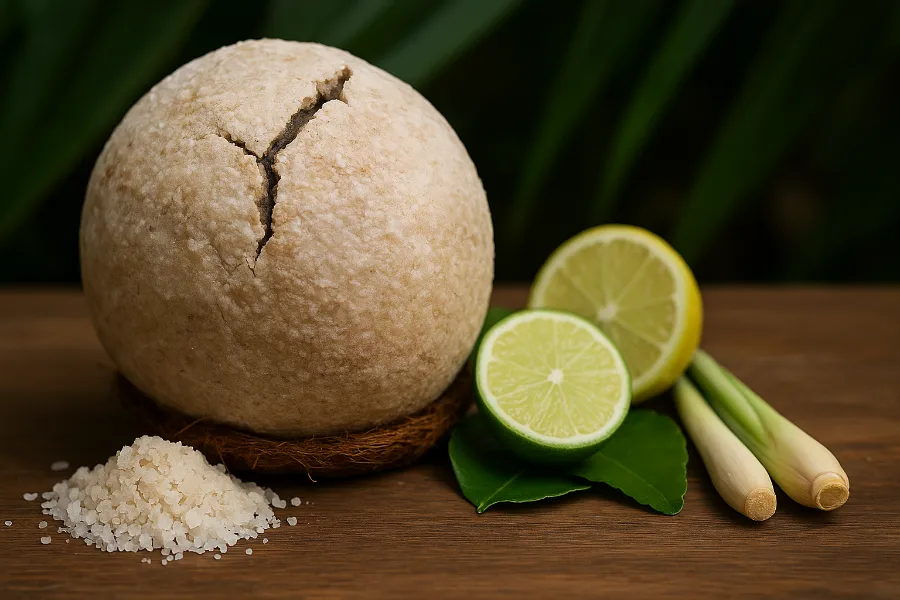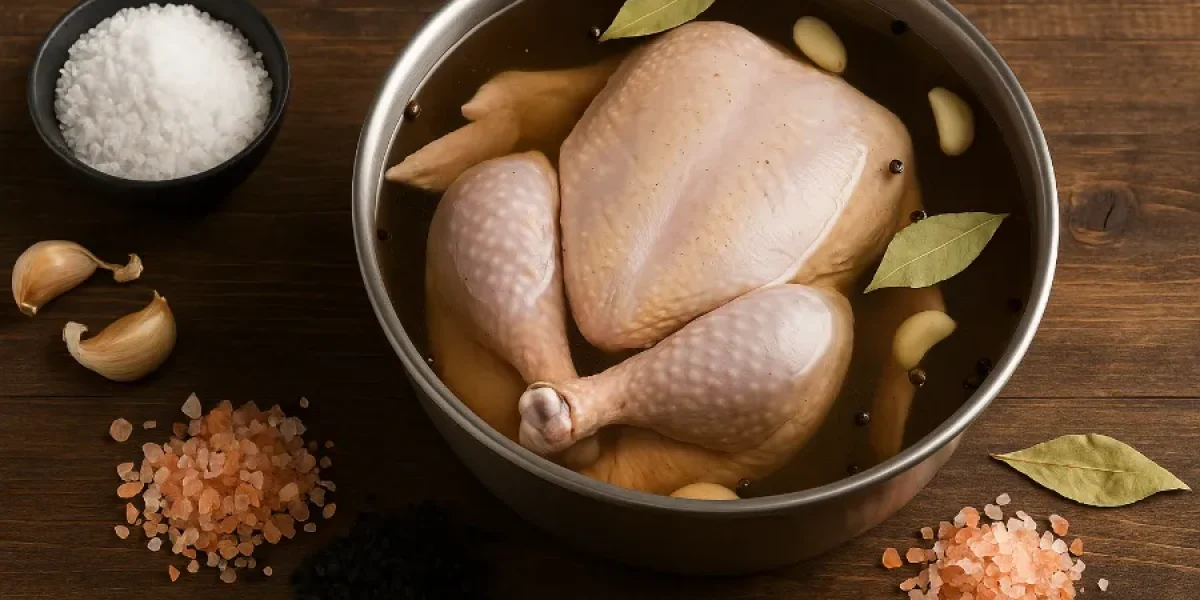If you’ve ever wondered why some home-cooked chicken turns out dry while restaurant chicken stays juicy and flavorful, the secret isn’t an expensive ingredient — it’s chicken brining.
I learned this lesson after too many bland Sunday roasts. Once I discovered the best salt ratio for chicken brine, everything changed. My chicken became tender, deeply seasoned, and delicious from the first bite to the last.
Brining is both an art and a bit of science. It’s simple to do, but precise in balance. Get the chicken brine ratio right, use the right brine salt, and your poultry will never be dry again.
In this guide, I’ll walk you through everything I’ve learned — from the basics of brine salt and how the ratio works, to exploring unique salt types like kosher salt, sea salt, pink salt, bamboo salt, flor de sal, Asin Tibook, kalamanak black salt, and Himalayan salt.
Brine Salt
Brine salt is the foundation of every good brine. When salt dissolves in water, it triggers osmosis — drawing moisture and seasoning deep into the chicken. The result is meat that’s juicy, flavorful, and forgiving even if you slightly overcook it.
Not all salts behave the same way. Some dissolve slower, others are stronger by weight, and many carry trace minerals that subtly change flavor. That’s why knowing which type of salt you’re using matters as much as the ratio itself.
When I’m short on time, I dissolve the brine salt in warm water, then chill it completely before submerging the chicken. And I always rinse and pat dry after brining — that’s how you get perfectly crisp, golden skin every time.
Chicken Brine Ratio
The chicken brine ratio is what guarantees success. After years of testing and tweaking, I’ve settled on the classic formula that never fails:
¼ cup of kosher salt per quart (4 cups) of water roughly 60 grams per liter for metric cooks.
That’s a 5–6% brine solution. It’s strong enough to season thoroughly without oversalting or changing texture.
For a whole chicken (about 4–5 pounds), I brine for 8–12 hours in the refrigerator. For smaller pieces like breasts or thighs, 2–4 hours is plenty.
If you’re using fine table salt, use less — around 3 tablespoons per quart — since it’s denser. When in doubt, weigh your salt for accuracy.
Chicken Salt
Many people confuse chicken salt with brine salt, but they’re very different.
Chicken salt is a seasoning blend usually salt mixed with herbs, spices, and sometimes dehydrated chicken flavor. It’s used after cooking for extra flavor on fries, roast chicken, or popcorn.
Brine salt, on the other hand, is pure salt used to soak raw chicken before cooking. It works by changing the muscle proteins so they hold onto moisture better.
If you love the taste of chicken salt, sprinkle it on your roast after brining and cooking — it layers flavor beautifully without replacing the science of a true brine.

Salt Types
Different salt types bring different textures, minerals, and flavors to your brine. Once you’ve mastered the ratio, experimenting with salts can elevate your chicken from simple to spectacular.
Below are the salts I’ve used and loved — each with its own character, benefits, and ideal use.
Kosher Salt
If I could only keep one type of salt in my kitchen, it would be kosher salt.
It’s coarse, pure, dissolves evenly, and gives you predictable results. Most brining recipes use kosher salt as the standard reference point.
Why it’s great:
- Clean, neutral flavor
- No additives or iodine
- Easy to measure consistently
One note: brands differ. Morton’s kosher salt is denser than Diamond Crystal. If you switch brands, adjust your volume — 1 cup Morton = about 1 ⅓ cups Diamond Crystal.
This is my everyday salt for brining. Simple, reliable, and easy to work with.
Sea Salt
Sea salt comes from evaporated seawater, so it naturally contains trace minerals like magnesium and calcium. These give it a slightly softer, rounder flavor.
When I want a more natural or coastal flavor — say, for lemon herb roast chicken — I reach for sea salt.
How to use it:
- Coarse sea salt: same ratio as kosher (¼ cup per quart).
- Fine sea salt: use about 20% less.
- Always dissolve fully in warm water before cooling the brine.
Chicken brined with sea salt often tastes subtly sweet and mineral-rich — especially good for grilling or roasting.

Pink Salt
When people hear pink salt, they sometimes think of curing salt — the type used for bacon or ham. That’s not what we mean here.
We’re talking about Himalayan pink salt, a mineral-rich rock salt mined from ancient seabeds. Its beautiful blush color comes from iron and trace minerals.
Why I like it for brining:
- Milder salinity
- Adds mineral complexity
- Naturally unprocessed
It dissolves slower than kosher salt, so give it extra time in warm water before chilling your brine. The flavor is subtle and clean, perfect when you want a more delicate taste.
Bamboo Salt
Bamboo salt, or Jukyeom, is a Korean specialty that’s roasted inside bamboo sealed with clay — sometimes up to nine times. The process infuses it with minerals and gives it a smoky, earthy note.
It’s slightly alkaline, which helps tenderize the meat while keeping the flavor balanced.
How I use it:
- About 3 tablespoons per quart (a bit less than kosher salt).
- Excellent for Asian-style brines with ginger, garlic, or soy.
- Adds depth and umami without overpowering.
The flavor is sophisticated earthy and savory, with a gentle finish. Perfect for when you want something truly different.
Flor de Sal
Flor de Sal means “flower of salt.” It’s the thin, delicate layer that forms on the surface of salt ponds and is harvested by hand. It’s considered one of the most luxurious salts in the world.
For brining, I treat Flor de Sal like a finishing salt or a delicate accent. Because it’s expensive and mild, I often mix it with kosher salt for the base brine.
How to use it:
- ¾ of your usual ratio if using it solo.
- Ideal for short brines (2–4 hours) or finishing touches.
- Sprinkle a pinch on roasted chicken just before serving for extra texture.
The flavor is light, oceanic, and subtly sweet — a true gourmet touch.
Asin Tibuok
Asin Tibuok is a traditional Filipino salt made by filtering seawater through coconut husks, then baking it into solid clay-like blocks. It has a rustic, smoky aroma and rich, earthy flavor.
To use it, you’ll need to grate it finely first — it’s rock-hard.
Best use:
- About ¾ cup per gallon of water.
- Combine with citrus, lemongrass, or ginger for a tropical flavor.
- Perfect for grilled or island-style chicken.
Every time I use Asin Tibuok, my kitchen smells like a seaside bonfire. It’s ideal for anyone who loves smoky, deep flavors without actually using a smoker.

Kalamanak Black Salt
Known as Kala Namak, this black salt is popular in South Asia and has a distinct sulfuric aroma that transforms under heat.
Used carefully, kalamajak black salt gives your chicken a savory umami boost, similar to aged soy or roasted garlic.
How to use it:
- Add 1–2 teaspoons per quart of water, combined with kosher or sea salt.
- Perfect for tandoori, curry, or barbecue-style chicken.
The sulfuric scent disappears as it cooks, leaving behind rich complexity. Just don’t overdo it — a little goes a long way.
Himalayan Salt
Although Himalayan salt and pink salt come from the same source, Himalayan salt deserves its own spotlight.
It’s unrefined, rich in minerals, and naturally balanced in flavor. I use it when I want clean, honest seasoning — the kind that lets the chicken shine without distractions.
Why it works:
- Provides smooth, even salinity.
- Ideal for both wet and dry brining.
- Adds gentle mineral sweetness.
Dissolve it completely before chilling your brine, and you’ll get beautifully seasoned, tender meat every time.
My Chicken Brining Process
Here’s my step-by-step method that never fails:
- Measure accurately: ¼ cup salt per quart of water (or the equivalent by weight).
- Dissolve completely: Warm half the water, dissolve salt, then add cold water to cool it down.
- Add aromatics: Garlic, peppercorns, bay leaves, citrus zest, herbs — whatever fits your flavor theme.
- Submerge the chicken: Make sure it’s fully covered; weigh it down if needed.
- Refrigerate: Brine for 8–12 hours for a whole chicken or 2–4 for smaller pieces.
- Rinse and dry: Rinse lightly to remove excess salt and pat completely dry for crisp skin.
- Cook: Roast, grill, or smoke as you prefer. The result will always be juicy and flavorful.
Why Brining Works
Brining works because salt changes the way proteins behave. In simple terms, the saltwater solution breaks down muscle fibers, allowing them to absorb more liquid. When you cook the chicken, those fibers hold onto moisture instead of squeezing it out.
The result is tender meat that’s seasoned through and through. Even if you slightly overcook it, brined chicken stays juicy.
Brining also helps flavor move inward. Instead of spices sitting just on the skin, they infuse every bite. It’s the difference between surface flavor and true depth.
Dos and Don’ts of Chicken Brining
Do:
- Use non-reactive containers like glass, stainless steel, or food-safe plastic.
- Weigh your salt if switching types or brands.
- Always cool your brine before adding raw chicken.
- Rinse and dry after brining to avoid excess salt.
- Let the chicken air-dry for at least an hour before cooking for crisper skin.
Don’t:
- Use iodized or flavored salts in your base brine.
- Over-brine beyond 24 hours — it softens the texture.
- Skip the chilling step — warm brine is unsafe for raw poultry.
- Mix salt types by volume without converting to weight.
The Final Word
When it comes down to it, chicken brining is one of the easiest ways to level up your cooking.
The best salt ratio for chicken brine — ¼ cup kosher salt per quart of water — is the foundation. Once you’ve mastered that, explore different salt types to create your signature flavor.
Try kosher salt for consistency, sea salt for natural balance, bamboo salt for umami depth, or Asin Tibuok for that island smokiness. Experiment until you find your perfect match.
Once you taste how juicy, flavorful, and tender brined chicken can be, you’ll never go back to skipping this simple step again.
FAQs
The best salt ratio for chicken brine is ¼ cup of kosher salt per quart of water (about 60 grams per liter). This balance seasons the chicken deeply without making it too salty.
Brine a whole chicken for 8 to 12 hours in the refrigerator. Smaller cuts like breasts or thighs only need 2 to 4 hours to achieve juicy, flavorful results.
Yes, but reduce the amount since table salt is denser. Use 3 tablespoons of table salt per quart of water to match kosher salt’s salinity.
Brine salt is pure salt used for soaking raw chicken, while chicken salt is a post-cooking seasoning mix with herbs and flavorings. They serve different purposes.
Kosher salt is the most reliable, but you can experiment with sea salt, Himalayan, bamboo, or Asin Tibook for unique mineral flavors.
Yes, give it a quick rinse to remove excess salt, then pat it completely dry. This helps achieve crisp, golden-brown skin during cooking.
Yes — over-brining can make chicken too salty and soft. Avoid soaking for more than 24 hours to maintain the perfect texture and flavor.













